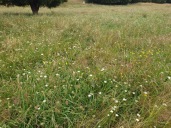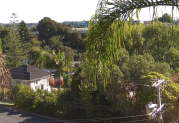The Tai Tokerau Climate Change Project aims to promote action to mitigate climate change. There are a wide range of actions we can all take to slow down and ultimately reverse global warming. We do this for our children and our mokopuna.
Direct cooling
A bigger lever?
Reducing emissions of CO2 and sequestering carbon is articulated widely as the main tool to mitigate climate change. But according to Australian soil microbiologist and climate scientist, Walter Jehne, CO2 only accounts for 4% of the drivers of heat dynamics.
The hydrological cycle, (the way that water moves through the environment) drives 95% of the planet’s heat dynamics. This gives us a much bigger lever for mitigating climate change. And for those not convinced, a big part of the remedy for both approaches is very similar – getting atmospheric carbon back into the soil.
These pages focus on the dynamics of direct cooling. They are under construction.
1. How direct cooling works 
Some places are hotter than others. This might be because of latitude, or elevation. But often neighbouring properties can differ significantly in temperature. Walter Jehne reports that locations in Canberra with lots of trees and be 12 degrees cooler than nearby treeless landscapes. (page under construction)
2. The science of direct cooling
Walter Jehne outlines 10 dynamics that drive the hydrological cycle that helps to explain how we can cool the planet. Click here for the first on these 10 dynamics.
3. Greening deserts
Deserts are increasing globally, but also efforts to green deserts are intensifying. more>>
4. Cooling farms 
Regenerative agriculture focuses on soil health and how to integrate more carbon into soils. (page under construction)
5. Urban cooling 
While the built environment only accounts for one percent of global land cover, the places we live differ widely in their heat dynamics. (page under construction)
6. Greening the desert of the mind
Sometimes the human mind is more arid than the harshest desert. We become captured by other peoples’ thinking and the ideologies that drive our economic and social constructions. This page explores the problem and solutions. (page under construction)
Soil carbon – a climate change silver bullet?
Thanks to Bev Trowbridge for her contribution to this article.
Organic matter performs wonders in the soil. It stores water but facilitates drainage, binds soil particles, but enables easy root penetration and so much more. With concerns about climate change getting more organic matter in the soil is a great way to sequester carbon.
According to this Food and Agriculture Organisation (FAO) video, despite the way we have depleted the soils, an estimated 1417 gigatonnes of carbon remain in the first metre of soil across the globe, almost double the amount of CO2 in the atmosphere. The answer, or at least a part of the answer, lies in the soil, and increasing its carbon content.
In 2016 the FAO published the Voluntary Guidelines for Sustainable Soil Management. The document identifies the problem of soil degradation and the compelling reasons to implement solutions.
A loss of soil organic carbon (SOC) due to inappropriate land use or the use of poor soil management or cropping practices can cause a decline in soil quality and soil structure, and increase soil erosion, potentially leading to emissions of carbon into the atmosphere. On the other hand, appropriate land use and soil management can lead to increased SOC and improved soil quality that can partially mitigate the rise of atmospheric CO2. (page 8)
So the answer, or at least a part of the answer, lies in the soil, and increasing its carbon content. The document outlines the characteristics of sustainable soil management (page 3):
- Minimal rates of soil erosion by water and wind;
- The soil structure is not degraded (e.g. soil compaction) and provides a stable physical context for movement of air, water, and heat, as well as root growth;
- Sufficient surface cover (e.g. from growing plants, plant residues, etc.) is present to protect the soil;
- The store of soil organic matter is stable or increasing and ideally close to the optimal level for the local environment;
- Availability and flows of nutrients are appropriate to maintain or improve soil fertility and productivity, and to reduce their losses to the environment;
- Soil salinization, sodification and alkalinization are minimal;
- Water (e.g. from precipitation and supplementary water sources such as irrigation) is efficiently infiltrated and stored to meet the requirements of plants and ensure the drainage of any excess;
- Contaminants are below toxic levels, i.e. those which would cause harm to plants, animals, humans and the environment;
- Soil biodiversity provides a full range of biological functions;
- The soil management systems for producing food, feed, fuel, timber, and fibre rely on optimized and safe use of inputs; and
- Soil sealing is minimized through responsible land use planning.
More on soil carbon
Max Purnell, a farmer from Hauraki secured Christine Jone’s help to design his pasture mix and management. This video shows impressive results.
Applying this to Northland
A good starting point to use a document with the authority of the FAO behind it. The challenge is then to apply it to local conditions. Many factors combine to determine how best to apply soil management strategies, the nature and texture of the soil, its degree of degradation, crops grown, topography and socio-cultural factors to name a few. The best strategies will build on local successes.
These links are to videos of people achieving success in diverse locations.
- Allan Savory fighting desertification. Here is a link to Allan Savory’s website.
- Willie Smits- How to restore a rain forest.
- Regenerative agriculture case studies from Australia.
- Department of Agriculture (Australia) biochar trials.
- Salatin farm.
Other resources
- Christine Jones’s website (Amazing Carbon)
- Soil solutions website
- Carbon farming group (Tindall Foundation)
- Regrarians website.
- Call of the Reed Warbler (book by Charles Massey)
- Making Small Farms Work (book by Richard Perkins)
- Carbon: Soils secret to saving civilisation, John King
A virtuous circle
There are plenty of vicious circles in climate dynamics – where actions interact and compound to increase climate extremes. For example, as ice melts, its reflective ability is lost and the darker ocean water is exposed to more heat. As temperatures rise, fire becomes more common, incinerating biomass and carbon, and exposing the soil, leading to erosion and further loss of organic matter.
While increasing soil organic matter sequesters carbon, it also exponentially improves soil quality to create greater biomass, and store more water and nutrients. Resilient soils support our resilience.
Here is Albert Bates talking about biochar, #72 Drawdown solution.